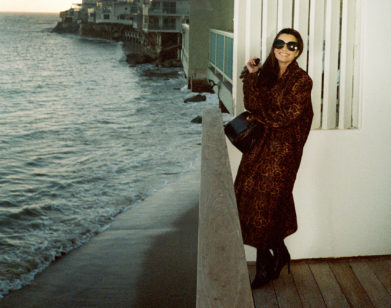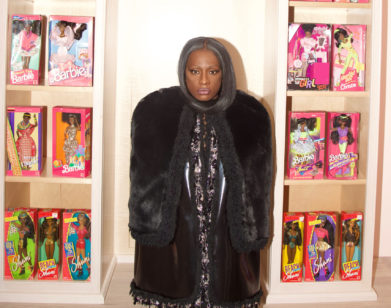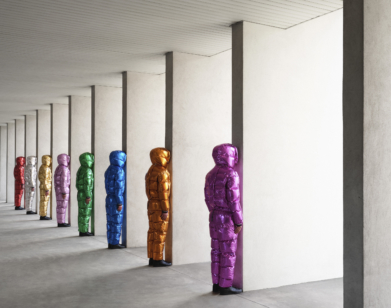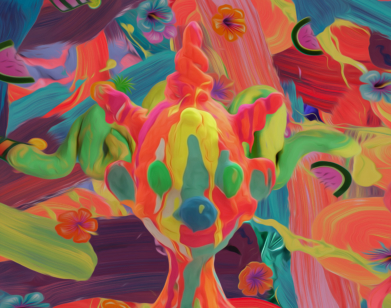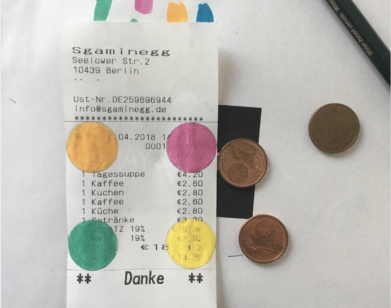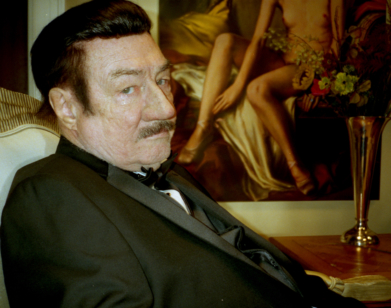Fran Drescher Is Not A Regular Nanny—She’s an Art Nanny
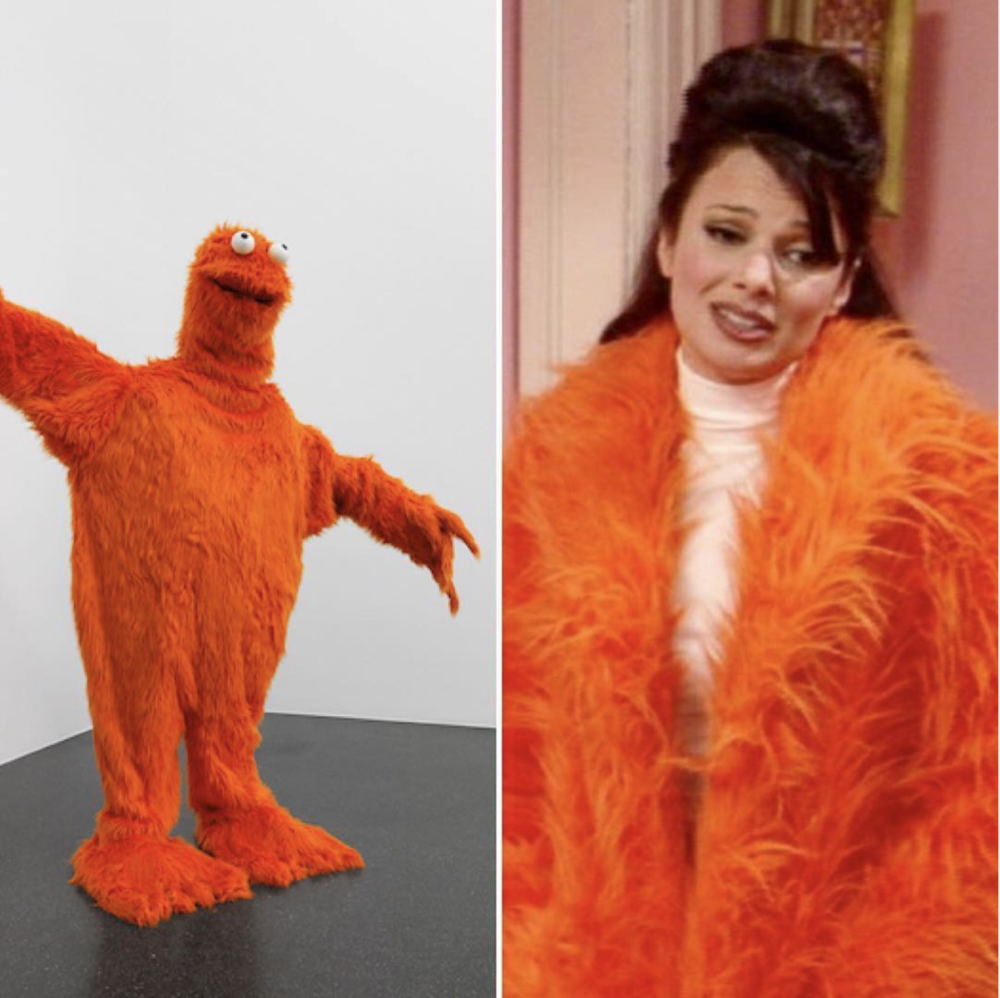
A sculpture by Stefan Tcherepnin from his show “Stefan ‘Jackson’ Tcherepnin, 2014-17: The Missing Years” next to a photograph of Fran Drescher as Fran Fine in The Nanny. All images courtesy @thenannyart.
Fran Drescher has just finished taping the pilot of a new NBC comedy called Indebted with Adam Pally and Abby Elliot. The show begins with Drescher and her husband, played by Steven Weber, arriving on the doorstep of their son’s home saying, “We’re dead broke and we need to come live with you.” It’s not the first time Drescher has appeared unexpectedly on a doorstep. In 1993, as a teenager in the ’90s, I watched her arrive, as Fran Fine, at the door of Broadway producer Maxwell Sheffield and his three children in the cult sitcom The Nanny. The series, created and produced by Drescher and her real-life husband Peter Marc Jacobson, turned Fran Fine into a fashion icon, and she quickly became one of the most lovable characters on ’90s television—and my personal hero.
A few months ago, I came across a still shot from The Nanny that recalled a classic the 1988 Gerhard Richter painting “Betty.” When I posted a photo combining the two images on Instagram, I received an instant flood of likes. Fran Fine, it turns out, remains lodged in the collective memory of my generation. I was soon inspired to create the Instagram account @thenannyart, in which I place her signature looks in conversation with various works of contemporary art. From a mini-skirt that resembles a Piet Mondrian painting to a velour Emanuel Ungaro suit paired with a painting by Christopher Wool, the account shows how art can pop up in unexpected contexts. Ultimately, Fran Fine is the televisual embodiment of fine art: she’s the lady in red when everybody else is wearing tan.
When I discovered that Fran Drescher is not only a fan of the account, but an avid art collector herself, I decided to talk with her ahead of her cabaret dinner cruise benefit on June 24. (Drescher is a cancer survivor who detailed her battle the book Cancer Schmancer.) America’s favorite nanny spoke about the place of art in her life, from her childhood reading about Vincent Van Gogh to her recent bittersweet sale of an Alex Katz.
———
LOUIS-PHILIPPE VAN EECKHOUTTE: What sparked your interest in collecting?
FRAN DRESCHER: When I first started in the business and came to California, I was just shy of 20 years old. I met Elaine Rich and her husband, a couple who were art collectors. At one time they owned an art gallery on Madison Avenue, but he always wanted to go back to acting. They sold everything in New York and moved west. She became my theatrical manager. He started working as a character actor. They were very worldly, sophisticated, charming people who were a huge influence on me, especially Elaine. It was through their exposure to art that I began to get bit by the bug of collecting. When I was a child, I loved art. I remember one of my earliest books was about Vincent Van Gogh and when I was in elementary school, outside of the principal’s office was a print of Georges Seurat’s “Sunday on La Grande Jatte.”
VAN EECKHOUTTE: That’s a great work.
DRESCHER: Every time I passed it, I would look at it and try and will myself into that painting. I tried to challenge myself to recognize different paintings and artists and become familiarized with their styles because I was so in awe that Elaine could look at a painting and say, “Oh, that’s a this. Or that’s a that.” I thought, “How do you know that?” She said that the more you look at them, the more you begin to recognize different artists’ styles. I think that my abilities to direct, produce, create an ambiance in my home décor, and dress have been informed by my more refined eye.
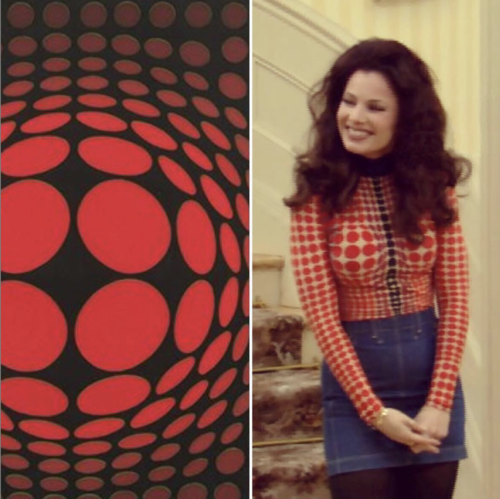
“Untitled” by Victor Vasarely and Fran Fine.
VAN EECKHOUTTE: In your book Cancer Schmancer, you write about buying Botero’s “Reclining Woman” the same week you found out that you had cancer. Does art have a therapeutic value for you?
DRESCHER: The hospital where I stayed was very mindful. They take a lot of donated art and hang it on their walls. I never realized what it would be like to be recovering from major surgery. Walking through those hallways and looking at the art made such a difference for me. Nobody should underestimate the importance of art in our lives. When I came home from the hospital after the surgery, the Botero sculpture was sitting on my coffee table waiting for me to return. That holds a very special meaning for me because life as I knew it was never the same again. That trip to the hospital divided my life from before cancer to after, and, waiting for me there, she was so beautiful and voluptuous and gorgeous. I hope I never sell her. Sometimes you have to sell art, like I just did for the first time.
VAN EECKHOUTTE: How did that feel?
DRESCHER: I’m still mourning. I heard about a sale in Hong Kong, and I was being pursued for my glorious Alex Katz of his most celebrated subject, his wife Ada. The minute I said, “Okay, take it,” I had flow, like I unclogged. As soon as I let go of the painting, I suddenly got the pilot, I have a talk show I’m in negotiations with, and I’m writing a musical for Broadway that’s moving forward at a very healthy pace.
VAN EECKHOUTTE: One door closes and another one opens.
DRESCHER: That’s energy. Sometimes you can’t hold on to everything. I just hope they hang her in their home and don’t put her in some art storage, which would really break my heart. Life is about letting go and being free, not getting so attached to things that you feel buried alive.
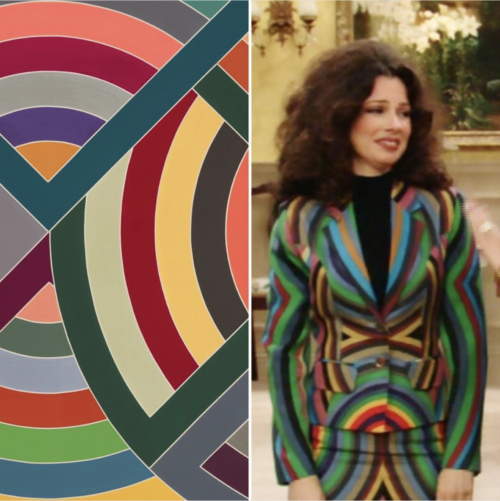
“Firuzabad” by Frank Stella and Fran Fine.
VAN EECKHOUTTE: What does the future look like for the Cancer Schmancer movement that you’ve started?
DRESCHER: We have a big cabaret dinner cruise in New York Harbor to the Statue of Liberty on June 24th, and we get the best of New York cabaret to perform and I speak. It’s a spectacular evening in support of our efforts. On Earth Day, we released a half-hour long educational video online for free called “Be The Change.” It’s got Jamie Foxx in it, Jeff Bridges, and me. It’s targeting teens to educate, motivate, and activate them into being more mindful consumers because they’re the first generation in history predicted to not live as long as their parents. We don’t want to make that a self-fulfilling prophecy, so we’re targeting them to wake up and realize that big business manufacturers and advertisers may not have their best interest at heart, but they can be great influencers because what they buy and don’t buy becomes their vote and protest. This is a big part of the Cancer Schmancer mission—to take control of your body.
VAN EECKHOUTTE: You inspired me to make an Instagram account that focuses on the outfits of The Nanny. Were you aware of the strong connection between the clothes and art history during the making of the series?
DRESCHER: Brenda Cooper, the original costume designer of the series who won an Emmy for her work, recalls when we were in a wardrobe session, and I put orange and pink together. She said, “I don’t know, those two colors seem to clash.” I said, “They’re Gauguin colors. They don’t clash at all, they’re exquisite.” The minute I put it in the context of fine art, she saw it. Later she told me never to forget that moment because I opened her eyes to seeing things through the eyes of a great painter.
VAN EECKHOUTTE: You look through the lens of art.
DRESCHER: I’m very grateful for that. When I work as a director, that’s setting up cameras and composition, and I when I look in the lens and compose a shot, it’s without question influenced by the fact that I’ve cultivated my eye through fine art. You think about depth of field differently, and the edges of the frame—all of it.
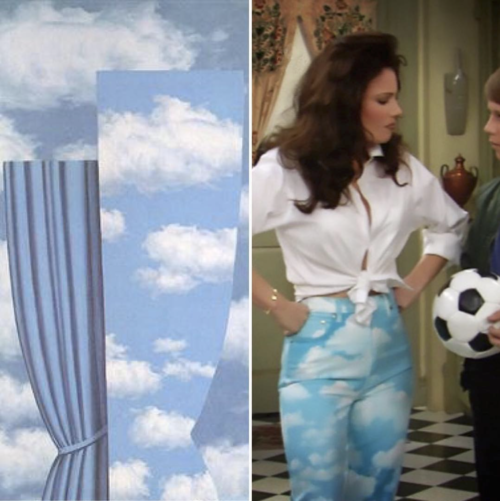
“Le Beau Monde” by René Magritte and Fran Fine.
VAN EECKHOUTTE: Would you ever consider sitting for a portrait, and who would be the ideal artist to make it?
DRESCHER: I am a big fan of John Currin. I went to a massive show of him in New York at Gagosian Gallery a few years back, and every time he’s featured at a museum or a gallery, I love to go. I know him and his wife, I’ve met them over the years. I don’t own one of his pieces. I wish I did, but the ones that I like are a little out of my price range.
VAN EECKHOUTTE: He’s one of the greatest portraitists of our time.
DRESCHER: I was once talking to Chuck Close, and he had been quoted as saying that Madonna wanted to commission him to paint her, but he declined the offer because he felt that she was too masked. When I met him, I said, “You know, if you ever want to paint me, I would be honored.”
VAN EECKHOUTTE: What did he say?
DRESCHER: He said, “Would you pose nude?”
VAN EECKHOUTTE: Oh dear.
DRESCHER: I said, “Sure.” I gave him my card, but I never heard from him.

